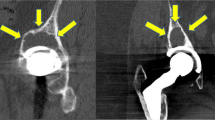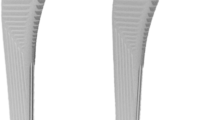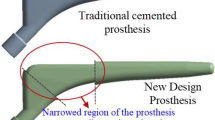Abstract
Introduction
Even following the introduction of the “third generation” cementing technique, an improvement of the fixation of the acetabular component similar to that of the femoral has not been shown in clinical studies. The goal of the present study was to achieve a better stability with the use of an amphiphilic bonder while preserving the mechanically important subchondral sclerosis.
Materials and methods
In a total of 20 sheep, a cemented total hip replacement was implanted. In the treatment group (n = 10), the implantation was carried out following surface conditioning of the acetabular bed with an amphiphilic bonder. All the sheep were followed for 9 months. To assess the biocompatibility, the osseous ingrowth at the cement–bone interface was depicted with the help of an in vivo fluorescent marking of the osteoblasts. Additionally, conventional radiographs were obtained over the course of treatment. Finally, the ovine pelvic regions were split following a standardized technique allowing for histological evaluation of the cement–bone interfaces.
Results
The acetabular components of the treatment group revealed a stable cement–bone compound. In the control group, the implants were easily dislodged from their beds. This finding was consistent with the radiological and histological results, which had revealed increased, progressive lytic radiolucent lines and the interposition of fibrous tissue at the cement–bone interface in the control group compared to the treatment group. The bonder was biocompatible.
Conclusion
Following the application of the bonder, the cemented acetabular components revealed an improved stability without signs of inflammation or neoplasia in a viable acetabular osseous bed. With the help of this technique, the in vivo longevities of cemented acetabular components can be increased in the clinical setting without sacrificing the biomechanical relevant subchondral sclerosis.







Similar content being viewed by others
References
Bergmann G, Graichen F, Rohlmann A (1999) Hip joint forces in sheep. J Biomech 32:769–777
Breusch SJ, Berghof R, Schneider U, Weiß G, Simank HG, Lukoschek M, Ewerbeck V (1999) Der Stand der Zementiertechnik bei Hüfttotalendoprothesen in Deutschland. Z Orthop 137:101–107
Breusch SJ, Schneider U, Kreutzer J, Ewerbeck V, Lukoschek M (2000) Einfluß der Zementiertechnik auf das Zementierergebnis am koxalen Femurende. Orthopäde 29:260–270
Brumby SA, Howie DW, Pearcy MJ, Wang AW, Nawana NS (1998) Radiographic and histologic analysis of cemented double tapered femoral stems. Clin Orthop Rel Res 355:229–237
DeLee JG, Charnley J (1976) Radiological demarcation of cemented sockets in total hip replacement. Clin Orthop 121:20–32
Ebramzadeh E, Normand PL, Sangiorgio SN; Llinas A, Gruen TA, McKellop HA, Sarmiento A (2003) Long-term radiographicchanges in cemented total hip arthroplasty with six designs of femoral components. Biomaterials 24:3351–3363
Eftekhar NS, Nercessian O (1988) Incidence and mechanism of failure of cemented acetabular component in total hip arthroplasty. Orthop Clin North Am 19:557–566
Engh CA, Griffin WL, Marc CL (1990) Cementless acetabular components. J Bone Joint Surg Br 72:53–59
Erli HJ, Marx R, Paar O, Niethard FU, Weber M, Wirtz DC (2003) Surface pretreatments for medical application of adhesion. Biomed Eng Online 18:15
Garcia-Cimberlo E, Munuera L, Diez-Vazquez V (1995) Long-term results of aseptic cemented Charnley revisions. J Arthroplasty 10:121–131
Garcia-Cimbrelo E, Vazquez V, Madero R, Munuera L (1997) Progression of radiolucent lines adjacent to the acetabular component and factors influencing migration after Charnley low-friction total hip arthroplasty. J Bone Joint Surg 79-A:1373–1380
Griss P (1998) Hybrid total hip arthroplasty. In: Sedel J, Cabanela ME (eds) Hip surgery materials and developments. Martin Dunitz Ltd., London
Harris WH (1992) Is it advantageous to strengthen the cement–metal interface and use a collar for cemented femoral components of total hip replacements? Clin Orthop 285:67–72
Huiskes R (1993) Failed innovation in total hip replacement diagnosis and proposal for cure. Acta Orthop Scand 64:699–716
Karrholm J, Snorrason F (1993) Subsidence, tip, and hump micromovements of noncoated ribbed femoral prostheses. Clin Orthop Relat Res 287:50–60
Kavanagh BF, Ilstrup DM, Fitzgerald RH (1985) Revision total hip arthroplasty. J Bone Joint Surg Am 67:517–526
Kobayashi S, Terayama K (1990) Radiology of low-friction arthroplasty. A comparison of socket fixation techniques. J Bone Joint Surg Br 72:439–443
Linder L, Carlsson AS (1986) The bone–cement interface in hip arthroplasty: a histologic and enzyme study of stable components. Act Orthop Scand 57:495–500
Malchau H, Soderman P, Herberts P (2000) Swedish hip registry: results with 20-year follow-up with validation clinically and radiographically. 67th annual meeting of the AAOS, Orlando
Marx R, Fischer H. Werkstück und Verfahren zum Herstellen und zum Verwerten des Werkstücks. München: Patentanmeldung PCT/DE 00/02702, 2000
Marx R, Weber M (2001) Vollkeramische Kronen- und Brückenmaterialien-Eigenschaften und Anforderungen. Eigenverlag F&E-Labor Medizinische Werkstoffe RWTH Aachen, Aachen
Massin P, Vandenbussche E, Landjerit B, Augereau B (1996) Experimental study of periacetabular deformations before and after implantation of hip prostheses. J Biomech 29:53–61
Mulroy WF, Harris WH (1996) Revision total hip arthroplasty with use of so-called second-generation cementing techniques for aseptic loosening of the femoral component: a fifteen years-average follow-up-study. J Bone Joint Surg Am 78:325–330
Mumme T, Gravius S, Andereya S, Marx R, Wirtz DC, Müller-Rath R (2007) Improvement of the long-term adhesive strength between bone cement and bone in cemented cup arthroplasty. Arch Orthop Traum Surg 11 (Epub ahead of print)
Nakabayashi N, Pashley DH (1998) Hybridization of dental hard tissues. Quintessence Books, Tokyo
Nunn D, Freeman MA, Hill PF, Evans SJ (1989) The measurement of migration of the acetabular component of hip prostheses. J Bone Joint Surg Br 71:629–631
Phillips TW, Johnston G, Wood P (1987) Selection of an animal model for resurfacing hip arthroplasty. J Arthroplasty 2:111–117
Ratanasathien S, Wataha JC, Hanks CT, Dennison JB (1995) Cytotoxic interactive effects of dentin bonding components on mouse fibroblasts. J Dent Res 74:1602–1606
Smith SE, Estok DM, Harris WH (2000) 20-year experience with cemented primary and conversion total hip arthroplasty using so-called second generation cementing techniques in patients aged 50 years or younger. J Arthroplasty 15:263–273
Sochart DH, Porter ML (1997) The long-term results of Charnley low-friction arthroplasty in young patients who have congenital dislocation, degenerative osteoarthritis, or rheumatoid arthritis. J Bone Joint Surg Am 79:1599–1617
Waide V, Cristofolini L, Toni A (2004) An experimental analogue to model fibrous tissue layer in cemented hip replacements. J Biomed Mater Res Part B Appl Biomater 69B:232–240
Wetherell RG, Amis AA, Heatley FW (1989) Measurement of acetabular erosion: the effect of pelvic rotation on common landmarks. J Bone Joint Surg Br 71:447–451
Wirtz DC, Lelgemann B, Jungwirth F, Niethard FU, Marx R (2003) A new method to optimize the adhesion between bone cement and acetabular bone in total hip arthroplasty. Z Orthop 141:209–216
Wirtz DC, Niethard FU (1997) Ursachen, Diagnostik und Therapie der aseptischen Hüftendoprothesenlockerung-eine Standortbestimmung. Z Orthop 135:270–280
Author information
Authors and Affiliations
Corresponding author
Rights and permissions
About this article
Cite this article
Müller-Rath, R., Wirtz, D.C., Siebert, C.H. et al. Amphiphilic bonder improves adhesion at the acrylic bone cement–bone interface of cemented acetabular components in total hip arthroplasty: in vivo tests in an ovine model. Arch Orthop Trauma Surg 128, 701–707 (2008). https://doi.org/10.1007/s00402-007-0408-6
Received:
Published:
Issue Date:
DOI: https://doi.org/10.1007/s00402-007-0408-6




